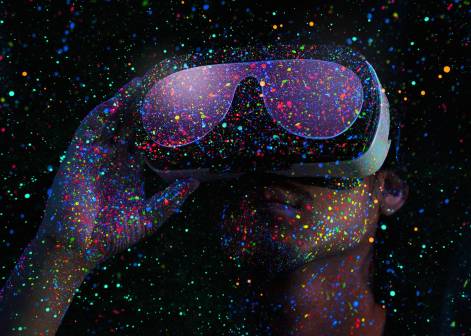Why one liberal arts college is betting on VR

Virtual reality’s place in higher education is still to be determined, but educators at one private four-year college are bullish on the technology’s prospects for boosting student engagement.
Catawba College, a small, private liberal-arts school in North Carolina, is planning to bring VR technology from the California firm Dreamscape Learn into classrooms this fall. Carmony Hartwig, an associate professor of biology at Catawba, told EdScoop that her first time strapping on a headset to interact with Dreamscape’s virtual scenarios made her feel “giddy, almost in tears” as she imagined how such immersion might draw students into her beloved field of biology.
“I feel like this is something that’s going to help my students to engage in a totally different way, with the material that they’ve probably been introduced to before, but it may not have been as exciting,” she said. “This technology is so immersive that it pulls you into the story and it makes it more like a storyline that you’re actively and emotionally involved in.”
Hartwig said she tested one of Dreamscape’s scenarios last fall at Arizona State University, where virtual reality has replaced wet labs for its biology 101 courses. She described the scenario as a scientific mission in which students investigate the ailing health of an alien life form. By switching between examining the organism and conducting experiments in a virtual lab, students are nudged toward an emotional attachment to the creature’s outcome.
Dreamscape Learn executives told EdScoop that incorporating storytelling to immerse students in learning is one of the reasons their technology is effective in classrooms. After a research study at ASU on Dreamscape Learn’s technology, the company claims that students who attend courses that use its product are nearly twice as likely to receive an “A” grade. (Michael Crow, Arizona State University’s president, co-founded DreamScape Learn alongside Hollywood film producer Walter Parkes, whose resume includes films such as Gladiator and Men In Black.)
At Catawba College, which enrolls about 1,200 students, roughly 100 biology students are expected this fall to interact with Dreamscape Learn’s virtual scenarios. Hartwig, a microbiologist who said she is fascinated by parasites, and whose research features terms like “ethnopharmacological potential” and “falciparum gametocytes,” admitted that biology can be confusing.
“It’s such a different way of learning. You’re learning without realizing how much you’re learning,” she said. “I can actually be in a space with my students in the virtual world and we can interact with all these things and I can show them all the things normally I would talk about in real time and we can manipulate it in real time.”
Hartwig said VR won’t replace her college’s laboratory assignments, but will provide an additional “modality” that gives students new inroads to connect with a challenging subject.
As an industry, VR in higher education has plodded along the last few years, gaining support at institutions that can afford to provide their students the novel experience of exploring virtual worlds, or at colleges that receive philanthropic support or special grant funding.
Morehouse College, a historically Black institution in Atlanta, in 2022 adopted VR headsets and educational virtual reality software from the Iowa tech firm VictoryXR. Educators there said its uses of VR — which included a slave ship simulation designed to augment English and history courses, and virtual copy of the college’s campus — were helping students to engage with their subjects, learn faster and feel more connected to their surroundings.
In a publication last year, the nonprofit Educause noted that enthusiasm for virtual reality and augmented reality technologies are “somewhat tempered by the slow growth of off-the-shelf educational content.” Researchers also pointed to various successful uses of VR in higher education, including for training medical students on topics ranging from basic anatomy to bedside manner. But the group was unwilling to predict where the technology will be in five years.
“Early exploratory projects show promise, but a great deal of policy development, curricular design, and evaluation work lie ahead,” the paper read.
Josh Reibel, Dreamscape Learn’s chief executive, told EdScoop that his company’s pitch to higher education is not merely a novel experience, but an immersive educational tool that has already proven to boost outcomes.
“Especially in introductory STEM courses, it’s not a secret that lots of students, especially students that are not well prepared for post-secondary education, sort of drift off,” Reibel said.
A majority of students in science, technology, engineering and mathematics majors do not graduate with degrees in their chosen fields, and about one-fifth wind up dropping out altogether, according to researchers at the Stevens Institute of Technology.
Beyond the substance of Dreamscape’s immersive scenarios, Reibel said they get students “excited and energized.”
“Our founder comes from the movie business and so obviously knows a lot about how to create engaging narratives and we’re really leaning into that use of cinematic storytelling to get students to, in a really authentic way, feel like they are the protagonists in a drama that has all of the twists and turns and suspense and emotional draw that good episodic entertainment does,” he said. “But not in a way that turns the learning into edutainment.”
In the case of Dreamscape’s biology program, for every fifteen minutes in VR, students spend two or three hours doing traditional classroom work. Reibel said VR is an effective way to motivate problem-based learning because its emotional salience and immersive quality leads students to suspend disbelief in scenarios that might seem unconvincing if presented in video or text.
“It’s about making school less a series of discrete tasks that are decontextualized and more a really exciting mission that you’re on,” he said. “And what we’ve found is students are willing and able to do a lot of very hard work once it’s presented in that context, that they otherwise just kind of flail on.”





